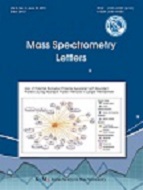
- P-ISSN 2233-4203
- E-ISSN 2093-8950

Understanding the mechanisms that control and concentrate the observed electrospray ionisation (ESI) response from peptides is important. Controlling these mechanisms can improve signal-to-noise ratio in the mass spectrum, and enhances the generation of intact ions, and thus, improves the detection of peptides when analysing mixtures. The effects of different mixtures of aqueous: organic solvents (25, 50, 75%; v/v): formic acid solution (at pH 3.26) compositions on the ESI response and chargestate distribution (CSD) during mass spectrometry (MS) were determined in a group of biologically active peptides (molecular wt range 1.3 - 3.3 kDa). The ESI response is dependent on type of organic solvent in the mobile phase mixture and therefore, solvent choice affects optimal ion intensities. As expected, intact peptide ions gave a more intense ESI signal in polar protic solvent mixtures than in the low polarity solvent. However, for four out of the five analysed peptides, neither the ESI response nor the CSD were affected by the volatility of the solvent mixture. Therefore, in solvent mixtures, as the composition changes during the evaporation processes, the pKb of the amino acid composition is a better predictor of multiple charging of the peptides.
Girod, M. (2011). . Int. J. Mass Spectrom, 308, 41-.
Winger, B. E. (1992). . J. Am. Soc. Mass Spectrom, 3, 624-.
Collettem C. (1998). . E. Rapid Comm. Mass Spectrom, 12, 165-.
Abaye, D. A. (2011). . Rapid Comm. Mass Spectrom, 25, 3597-.
Abaye, D. A. (2011). . Rapid Comm. Mass Spectrom, 25, 1107-.
Tang, L. (1993). . Anal. Chem, 65, 3654-.
Iavarone, A. T. (2001). . Anal. Chem, 73, 1455-.
Iavarone, A. T. (2003). . J. Am. Chem. Soc, 125, 2319-.
Carr, S. R. (1997). . J. Mass Spectrom, 32, 959-.
Chowdhury, S. K. (1990). . J. Am. Chem. Soc, 112, 9012-.
Kaltashov, I. A. (2008). . J. Am. Soc. Mass Spectrom, 19, 1239-.
Kebarle, P. (2009). . Mass Spectrom. Rev, 28, 898-.
Cole, R. B. (1993). . J. Am. Soc. Mass Spectrom, 4, 546-.
Wang, G. D. (1996). . J. Am. Soc. Mass Spectrom, 7, 1050-.
Sterner, J. L. (1999). . J. Am. Soc. Mass Spectrom, 10, 483-.
Iavarone, A. T. (2000). . J. Am. Soc. Mass Spectrom, 11, 976-.
Sunner, J. (1988). . Anal. Chem, 60, 1300-.
Nielsen, B. V. (2013). . Eur. J. Mass Spectrom, 19, 335-.
Kinoshita, M. (2001). . J. Mol. Liq, 90, 195-.
Bouchard, M. (2000). . Biophys. J, 78, 1010-.
Wang, G. D. (1994). . Org. Mass Spectrum, 29, 419-.
Karas, M. (2000). . Fresen. J. Anal. Chem, 366, 669-.
Braslavsky, S. E. (2007). . Pure Appl. Chem, 79, 293-.